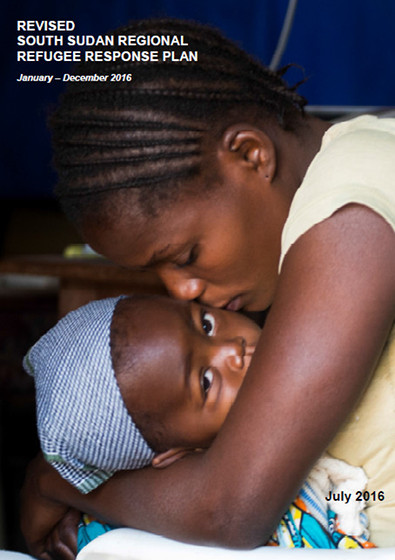A total of USD 701,6 million requested for the period January ‐ December 2016, including :
- USD 9,3 million for Central African Republic
- USD 14,8 million for Democratic Republic of the Congo
- USD 276,4 million for Ethiopia
- USD 49,5 million for Kenya
- USD 157,9 million for Sudan
- USD 193,7 million the for Uganda
Read the entire Revised Regional Refugee Response Plan and access the Latest Updates on the South Sudan Situation

The year 2016 has seen consistent and high numbers of new refugees from South Sudan. From January to May 2016, more than 125,000 South Sudanese refugees have sought asylum, mainly in Sudan (65,000 individuals) and Uganda (some 31,000 individuals). For the first time, the Central African Republic (CAR) and the Democratic Republic of the Congo (DRC) received refugees from South Sudan, as conflict and insecurity spread to new areas of the country. As of May 2016, the total number of South Sudanese refugees stands at more than 867,000 individuals, of whom some 744,000 people have fled since December 2013. Out of this total, some 70 per cent are children and close to 60 per cent are adult women.
The Agreement on the Resolution of the Conflict in the Republic of South Sudan signed in August 2015 represents a key opportunity to end the armed conflict that killed tens of thousands and left some 2.4 million people displaced inside and outside of South Sudan since the conflict broke out in mid-December 2013. On 26 April 2016, the South Sudan First Vice President Designate, Dr. Riek Machar, arrived in Juba and was subsequently sworn in as the first vice-president in a newly formed Transitional Government of National Unity (TGoNU), which will run the country for 30 months.
While the formation of the TGoNU is a positive step, human rights violations remain and the situation is volatile with localized conflict continuing in certain areas of the country, including those previously unaffected by conflict in Greater Bahr El Ghazal and Greater Equatoria. While small-scale spontaneous return movements have been observed in South Sudan the forced displacement inside and outside of the country continues.
In a statement issued on 4 May 2016, the United Nations Security Council called on South Sudan’s newly formed Transitional Government of National Unity to urgently remove impediments to the delivery of humanitarian assistance and to allow UNMISS free movement to exercise its mandate, including protection of civilians and investigation of human rights violations. Targeted sanctions remain in place for South Sudan, and a Panel of Experts is mandated to oversee implementation, gather, examine and analyse information regarding sanctions.
According to the Integrated Food Security Phase Classification of South Sudan, issued on 29 June 2016, up to 4.8 million people are projected to face severe food shortages over the coming months, with the risk of a food crisis continuing to threaten other parts of the country. This prognosis comes at a time of an unusually harsh season where roads become impassable and represents the highest level of hunger since the conflict began two and half years ago. Of particular concern are new areas of severe food insecurity such as Northern Bahr el Ghazal and Eastern Equatoria that have already started contributing to the outflow of the population.
The 2016 Regional Refugee Response Plan, launched in December 2015, was elaborated through a consultative process coordinated by UNHCR with the involvement of some 45 UN agencies and NGO partners; based on agreed planning figures it provides a framework for interagency interventions for the assistance and protection of the South Sudanese refugees.
In April 2016, UNHCR and Regional RRP partners agreed to revise the Regional RRP for 2016 based on the new large-scale influx of South Sudanese refugees between January and end April in the traditional asylum countries but also including the two new asylum countries, CAR and DRC. In the first four months of the year, Sudan had received 88 per cent of their planned 2016 population and Uganda had received 73 per cent of their anticipated annual arrivals. UNHCR and Regional RRP partners estimate based on the current trends, that the total population figure will approach one million South Sudanese refugees by the end of 2016.
A new agreed feature in the 2016 Revised Regional RRP is the inclusion of all South Sudanese refugees who were in the countries of asylum prior to the start of the conflict in December 2013. The rationale is to have a consolidated view of the needs and solutions for all South Sudanese refugees in the region.
An inter-agency coordination meeting called by UNHCR took place in Nairobi in May to discuss revising the 2016 Regional Refugee Response Plan and the Contingency Plan based on the new planning figures and the addition of CAR and DRC to the plan.
This current revision is therefore the result of collaborative work between UNHCR and Regional RRP partners at the country and regional levels, to plan for the rest of the year – from June to December 2016.

 FINANCIALS
FINANCIALS